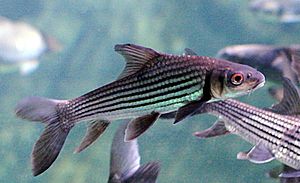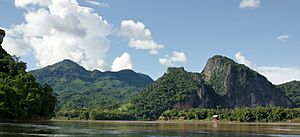Jullien's golden carp facts for kids
Quick facts for kids Jullien's golden carp |
|
|---|---|
 |
|
| Conservation status | |
| Scientific classification |
The Jullien's golden carp (Probarbus jullieni) is a special kind of fish that lives in freshwater. You can find it in rivers across Southeast Asia. Sadly, this fish is now endangered. This means there are not many left in the wild. Things like big farms and building dams for electricity are making it hard for them to survive.
Contents
About the Jullien's Golden Carp
What's in a Name?
A French scientist named Henri Émile Sauvage gave the Jullien's golden carp its name. He studied fish, reptiles, and ancient animals. The fish was named after J. Jullien, who likely collected the first sample. People also call this fish the carpilla ikan temoleh or the seven-striped barb.
This fish belongs to a large group of fish called Cypriniformes. Most fish in this group live in freshwater. They have fins with rays, but no sharp spines. The Jullien's golden carp is part of the Cyprinidae family. This family has more fish species than any other! It includes common fish like carp and minnows. These fish often have smooth, rounded bodies and thin lips.
How to Spot This Fish
The Jullien's golden carp has some unique features. You can easily spot its five long stripes along its body. It has special teeth in its throat called pharyngeal teeth. These teeth help it to crush its food.
Near its mouth, it has whisker-like feelers called barbels. These barbels help the fish feel its way around and find food. For swimming, it has a dorsal fin with one spine and nine soft rays. It also has five soft rays on its anal fin.
This fish can grow very big! It can be about 165 centimeters (over 5 feet) long. It can also weigh up to 70 kilograms (about 154 pounds). Jullien's golden carp can live for a long time, sometimes up to 50 years. They keep growing bigger as they get older.
What They Eat and How They Live
Jullien's golden carp enjoy eating freshwater shellfish, prawns, and aquatic plants. They eat more when there is plenty of food, usually during the wet season. When food is harder to find in the dry season, they eat less.
Like many river fish, their life cycle depends on the monsoon rains. This means they move to different parts of the river system throughout the year.
Reproduction and Migration
These fish travel a lot, especially when it's time to have babies. Adult fish swim upstream during the dry season. They gather in deep pools to lay their eggs. This is called spawning.
After the eggs hatch, the baby fish move into floodplains when the rainy season begins. So, their travels are all about the change from dry to rainy weather. This journey is super important for this endangered species to survive.
However, things like fish farming (aquaculture) and building dams for power threaten their homes. These activities can stop the fish from migrating, which puts their future at risk.
Where They Live
In the past, Jullien's golden carp lived in many rivers across Southeast Asia. These included the Mekong, Irrawaddy, Chao Phraya, Meklong, Pahang, and Perak River Basins. You could find them in countries like Thailand, Laos, Cambodia, Vietnam, Myanmar, and Malaysia.
Today, most of these fish live in the Mekong River Basin. Some smaller groups can still be found in the Pahang and Perak River Basins. They like to live in fast-moving water and clear, deep pools. During the rainy season, they stay in deep waters. But during the dry season, when they spawn, they move to shallower areas.
Why Jullien's Golden Carp Are in Danger
Fish Farming and Fishing
More and more, these fish are being raised on farms for aquaculture. This is common in Laos and Thailand. To catch wild fish for these farms, people use large nets called gill nets in places where the fish lay their eggs. This not only catches many wild Jullien's golden carp but also stops them from spawning. This makes their numbers even smaller.
In Malaysia, a research center is working on ways to breed these fish. The goal is to grow more fish for food. But sometimes, this focus on making money means less effort is put into saving endangered species like the Jullien's golden carp. People often prefer wild-caught fish, even if they are more expensive. This leads to illegal fishing in protected areas.
The government in Myanmar has made fishing for Jullien's golden carp illegal from February to April. This is to protect them during their spawning season. However, at other times of the year, the rules are not as strict. This makes it easy for people to catch too many of these fish.
Dams and Hydropower
Building dams for hydropower (electricity from water) is another big threat. Many dams have been planned or built on major rivers in Southeast Asia.
The Irrawaddy River Basin is one of the last safe places for the Jullien's golden carp. A dam called the Myitsone Dam in Myanmar was a big worry. But in 2011, its use was stopped because of efforts to protect the environment.
Another dam, the Xayaburi Dam in Laos, is also a threat. Since many Jullien's golden carp live in the Mekong River, this dam could be very bad for them. Dams can stop fish from moving upstream to lay eggs. This traps them in artificial lakes created by the dams. This can greatly reduce the number of fish available for local people to catch.
While dams bring in a lot of money for countries, they can harm traditional fishing and farming. Studies show that these industries could lose a lot of money if more dams are built. The problem of dams affecting fish is not new. In China, many dams on the Zhujiang River have caused the numbers of migratory fish, including carp, to drop. This shows what could happen to the Jullien's golden carp.
Pollution from Deforestation
When peat swamp forests are drained, the water in rivers like the Mekong becomes much more acidic. This pollution from cutting down forests also affects local people. For example, in Cambodia, deforestation has led to less food, soil washing away, and dirt building up in the water.
Even though there are laws against pollution in many Southeast Asian countries, they are often not enforced well. After forests are cut down, the land is often used to grow cash crops. These crops need a lot of energy to grow, and the leftover chemicals can run into rivers. This changes the water flow and harms the fish. Since the Jullien's golden carp's life depends on the changing water levels in rivers, this pollution has reduced their numbers.
Pollution from Farming
Laws against pollution from farming are also often not enforced. This is because countries want to grow their economies quickly. Many industries have expanded without proper ways to clean their water. This makes rivers have very little oxygen for much of the year. While farming methods are becoming more modern, this growth in cash crops is hurting the fishing industry. This means the region might not have many different types of industries in the future.
Helping the Jullien's Golden Carp
Global Efforts
The Mekong River Commission (MRC) was set up in 1995. It is an international group with four member countries: Laos, Thailand, Cambodia, and Vietnam. Its job is to study the effects of dams and other projects on the Mekong River. However, this group can only advise; it does not have the power to stop projects.
Recently, groups that care about people and the environment spoke out against the Myitsone Dam. They worked with a leader from Myanmar to pressure the government to stop using the dam. These groups also do not have legal power. So, they relied on getting support from people all over the world. Because Myanmar is becoming more democratic, the government listened to its people. But some people worry that the dam might still be used in the future.
Many research groups in Southeast Asia are studying how dams harm the environment and fish. The International Water Management Institute (IWMI) in Laos is one such group. These groups often work with other organizations to gain more power and make a bigger difference.
Local and National Efforts
In Malaysia, there is a project called Vita Tenggarra. It focuses on breeding endangered freshwater fish, including the Jullien's golden carp. This sanctuary has a large lake and many ponds. It aims to fight the problems of overfishing and pollution.
The project wants to breed fish to save them for the future. But it also hopes to make fish farming an important and sustainable business in the region. This means they want to create an industry that can last a long time without harming the environment. They encourage "catch and release" fishing, where people catch fish for fun but then let them go. This helps reduce overfishing. So, even if these projects have economic goals, they also aim to create better environmental policies.
The Mekong River Commission is trying to get a 10-year break on building new dams like the Myitsone Dam and the Xayaburi Dam. During this time, they would study the long-term effects of these dams on culture, the environment, and the economy. In 2011, Myanmar's President Thein Sein said he would set up this study because of public pressure. The Burmese government also stopped the Myitsone Dam project because of environmental worries. The dam would have flooded a large area, which is home to the Jullien's golden carp. This flooding would have messed up their migration. However, the Xayaburi Dam has not been stopped, even though many environmental groups are against it.
See also
- Mekong giant catfish
- Mekong River Commission
- Mekong
- Myitsone Dam
- Xayaburi Dam




